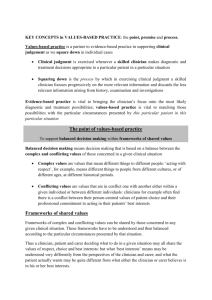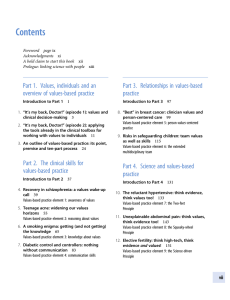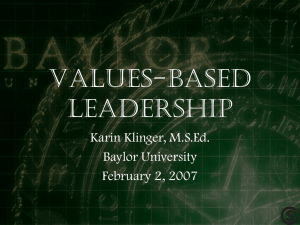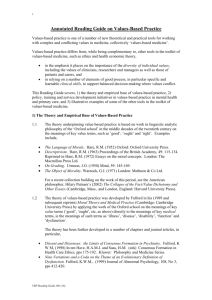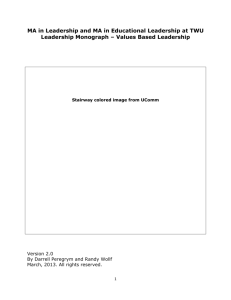Lecture Outline 15
advertisement
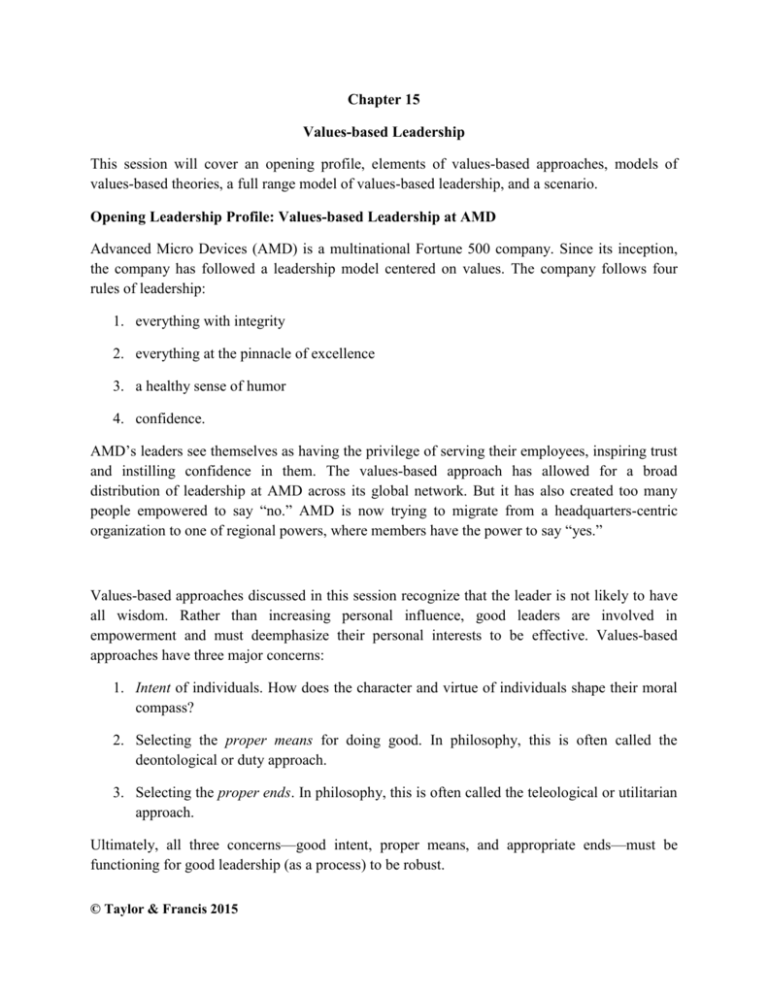
Chapter 15 Values-based Leadership This session will cover an opening profile, elements of values-based approaches, models of values-based theories, a full range model of values-based leadership, and a scenario. Opening Leadership Profile: Values-based Leadership at AMD Advanced Micro Devices (AMD) is a multinational Fortune 500 company. Since its inception, the company has followed a leadership model centered on values. The company follows four rules of leadership: 1. everything with integrity 2. everything at the pinnacle of excellence 3. a healthy sense of humor 4. confidence. AMD’s leaders see themselves as having the privilege of serving their employees, inspiring trust and instilling confidence in them. The values-based approach has allowed for a broad distribution of leadership at AMD across its global network. But it has also created too many people empowered to say “no.” AMD is now trying to migrate from a headquarters-centric organization to one of regional powers, where members have the power to say “yes.” Values-based approaches discussed in this session recognize that the leader is not likely to have all wisdom. Rather than increasing personal influence, good leaders are involved in empowerment and must deemphasize their personal interests to be effective. Values-based approaches have three major concerns: 1. Intent of individuals. How does the character and virtue of individuals shape their moral compass? 2. Selecting the proper means for doing good. In philosophy, this is often called the deontological or duty approach. 3. Selecting the proper ends. In philosophy, this is often called the teleological or utilitarian approach. Ultimately, all three concerns—good intent, proper means, and appropriate ends—must be functioning for good leadership (as a process) to be robust. © Taylor & Francis 2015 Models of value-based theories are the following: 1. the value-based leader as integrity personified 2. the value-based leader as moral manager 3. the value-based leader as authentic 4. the value-based leader as spiritual mentor 5. the value-based leader as transforming 6. a full-range model of values-based leadership. The first model is the essential core or foundation for values-based leadership in nearly all theories. The next four models offer contrasting, but not necessarily contradictory, perspectives on values-based leadership that build on basic leader morality. The final model covers a fullrange of scenarios. 1. The value-based leadership as integrity personified The basic meaning of integrity is wholeness, which in turn is based on notions of consistency in one’s own words, thoughts, principles, actions, and social setting. In philosophy, the three most common hallmarks of integrity are honesty, trustworthiness, and fairness. 1. Honesty. Honesty implies truthfulness in both private (self) as well as public (social) situations. However, this truthfulness connotes different meanings in different cultural contexts. 2. Trustworthiness. Trustworthy people articulate clear and consistent principles so others know where they stand. Very important in being considered trustworthy is following through on commitments, which is often called credibility, reliability, or dependability. The connotation of trustworthiness also varies across cultural contexts. 3. Fairness. Fair leaders do not indulge in “self-dealing” or use their position for personal gain, but rather share gain as equally as possible. They take the time to listen to all sides in disputes. Fairness also connotes different meanings in different cultural contexts. Differences in meanings of the various elements of integrity across cultures create ethical dilemmas or paradoxes for organization members. Trompenaars (2003) investigated implicit behaviors of people in different cultures using opposing hypothetical scenarios. One dilemma is whether a person would lie under oath to save a friend from serious consequences. In Germanic, Nordic, and Anglo nations, managers almost unanimously held that the friend had no right to expect them to perjure themselves. However, in Latin American, Latin European, and Confucian © Taylor & Francis 2015 Asian societies, most managers held that the friend did have some right, and that they would lie for a friend. 2. The value-based leadership as moral manager Moral management is sometimes called the duty approach, ethics training, or low-road approach, and stands for the leadership function of ensuring effective corporate governance by framing, communicating, enforcing, and adapting organizational expectations. The major concern of the approach is for organizational and social standards. The approach places emphases on ethical compliance with organizational or legal mandates, e.g. codes of conduct, professional standards. Weaknesses of the approach are the following: 1. Being ethical does not consist exclusively of prohibiting wrongdoing and reacting to threats against integrity. Being ethical is also about doing the right thing and doing things right, which are active, not passive pursuits. 2. In terms of implementation, the ethics or code training perspective can suffer when done poorly because of poor materials, superficial or lackluster training, and lack of pertinent examples, contradictory role models, and so forth. 3. The approach is trickiest when the authorized source or enforcer faces tough value tradeoffs, such as when a leader who values meeting stakeholder expectations faces strong pressures from shareholders or outsiders to generate super-normal performance, especially when a group, organization, or nation is under economic pressures or trying to meet competitive benchmarks. 3. The value-based leadership as authentic If the moral manager perspective emphasizes the external role of authorized values, authentic leadership emphasizes the internal perspective. Authentic leaders (or positive leaders) are selfaware in terms of their values, cognitions, and emotions. They control their ego-drives and defensiveness, which encourages openness, feedback, and genuine communication. Authentic leaders are adept at self-regulation in terms of emotional intelligence, self-improvement goals, and balanced congruence between actual and ideal selves. Major concerns of the approach are: concern for one’s own principles and values and concern for self-regulation (“positive” leadership) leading to confidence, optimism resilience, etc. The approach places emphases on self-awareness, self-improvement, open to feedback; nondefensive, “positive” influences on followers. © Taylor & Francis 2015 The strengths of an authentic leadership approach are many: 1. The authentic leadership construct takes into account an individual’s role beyond the passive acceptance of social norms. 2. It pays attention to the mutual and ongoing redefinition of moral norms. 3. It emphasizes the positive aspects of leaders taking charge of their emotional health and enhancing the moral awareness and emotional health of others. There are a number of challenges of the approach as well: 1. The definitions of authentic leadership seem somewhat amorphous and all-inclusive, and definitions tend to become circular. 2. There seems to be little consensus as to the exact constructs that make up authentic leadership, development, and followership. Consequently, this leads to issues of measurement and levels of analysis. 4. The value-based leadership as spiritual mentor The idea is the basic notion that people are to serve the king, prince, or potentate is backward and fundamentally wrong; it is the leader who is privileged to serve the people. Spiritual (or also called servant, affective, exemplar) leadership holds that it is the improvement in the well-being of the people, their empowerment, and the concomitant humility of the leader that is the measure of leadership greatness. The major concerns of the approach are concern for others (followers or clients) and concern for the community and environment. The approach places emphases on care and compassion; hope, faith, and spiritual well-being; work as a “calling”; emotional labor; sustainability. Strengths of the approach are the following: 1. It taps directly into the need to assist and make a difference. 2. Not only is spiritual leadership in its various forms a universalistic model, but it has great opportunity to be a situational model as well. Weaknesses of the approach are presented below: 1. Its abstraction from normal organizational authorization procedures and functions. 2. It is challenging to decide whether it is a normative or empirical approach and whether the ideal methods are prescriptive or descriptive. © Taylor & Francis 2015 3. Sometimes there is strong resistance to the normative thrust of servant leadership in the private sector, where the market can be seen as the primary source of wisdom. 5. The value-based leadership as transforming Burns (1978) notes that while transformational leaders as a class are concerned about change, whether for good, ill, out of personal ambition, or desire to do good, the great ones are transforming leaders. Transforming (adaptive) leaders are those who understand the need for change emanating from the people, can clarify those needs, and are able to create wholesome long-term change that would benefit society. The major concern of such leaders is making a wholesome change. These leaders place emphases on shared organizational or community vision; organizational or community adaptation; intellectual stimulation to improve organization or community. This view of leadership has the following strengths: 1. There is no doubt that change is a major and often critical function of leaders, especially executives. 2. Transforming leadership theory integrates managerial and normative values into a single model. 3. Transforming leadership is a model that requires leaders to subordinate their own needs and desires to those of the organization and affected community. Weaknesses of the approach: 1. Correctness in leadership, when measured in historical terms, is often tempered by success as much as by morality. 2. Transforming leadership is still heroic to the degree that it casts change as the primary function of leaders and suggests that other leadership functions are essentially inconsequential management details. 6. A full-range model of values-based leadership In summary, focused values-based perspectives on leadership are unified in the sense that leaders are supposed to take stock of their organizational, professional, and societal communities and then integrate the common good in process and product. The means of success as well as the ends are put in a social context that emphasizes equity and sustainability. Undergirding all values-based approaches is the personal integrity of those involved in the process. Honesty, trustworthiness, and fairness of individuals are the bedrock of a values-based perspective. © Taylor & Francis 2015 In reality, leaders have values-based preferences and the needs of the values-based landscape will vary significantly. An ideal values-based leadership would incorporate all the values-based perspectives discussed, all the time. Generally, leaders progress from being unethical, to being ethically neutral, to being ethically active, to engaging consistently in high levels of values-based leadership and thus being exemplary. A general model of values-based leadership differentiates good and exemplary characteristics as follows: The person of GOOD character will 1. recognize ethical issues 2. reflect on ethical issues 3. integrate the collective good into appropriate decisions. The person of HIGH character will ALSO 1. make a substantial contribution: Carry out a project or good work, and /or Increase the moral awareness of the community 2. OR exhibit sacrifices or courage for the common moral good: Deny oneself for the common good Suffer abuse for the common good Scenario: resolving the ethical conundrums 1. Rahim/Kiani: Rahim is relatively new but extremely hardworking. Kiani is competent but relatively slow and somewhat cavalier with customers. Both employees feel that they have earned the promotion and look to you to be fair. 2. Office lax on “petty stuff”: as a new manager who has completed a three-month review of your new assignment, you are sure that there are no large ethical issues. However, you have noted that the office has gotten exceedingly lax on the “petty stuff.” 3. Paloma choice to think things are getting done: it has been difficult for Paloma to stay up to date with new technology upgrades, and customers have been unrelenting in their requests for customization. Nonetheless, Paloma reasons with herself that the job is getting done. 4. Demoralized hospital workers and absence of salary increase: the hospital employees have been asking for salary increases to compensate for the tax increases, but the corporate board has turned down this request. © Taylor & Francis 2015 5. Need to reexamine financially unsustainable airline system: costs have almost doubled because of increasing fuel prices, higher salaries, and required maintenance. Your board has advised that you spend the bulk of your time working with the legislature, public, and unions to reexamine a system which has become unsustainable financially. 6. Decision on whether to support investigation against your best employees or not: You have been contacted by headquarters, which is about to indict some of your employees that offered illegal bribes to local government officials. Sadly for you, those being indicted are employees who have been supported by you and are your star performers. Analyze the case through the lens of values-based leadership. © Taylor & Francis 2015

